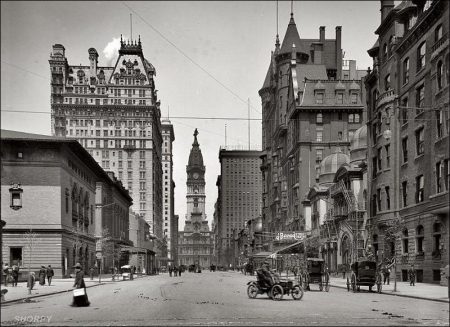Social life was a melange of the “humbug and frippery of an eastern city” and backwoods crudities, of New England ideals of education and religion, and frontier ribaldry. Churches were established as soon as congregations could be formed. Including the newlyarrived Irish, German, and Scandinavian groups, who composed more than one-third of the population, there were 20 congregations, all but one in their own buildings and nearly all self-supporting.
Methodism had the earliest start, in 1831. Catholics, Baptists, Presbyterians, formed congregations in 1833, followed the next year by Episcopalians, and by Universalists and Unitarians in 1836, Swedenborgians in 1842, and Jews in 1847. Private and semi-private schools preceded the first permanent establishment of free schools in 1841. Rush Medical College, initiated in 1837, soon had a city hospital.
Beginning in 1848, canal and railroad penetrating the fertile farmlands gushed torrents of city-building nourishment into Chicago. The city had quadrupled in size in its seven years of plenty, fed only by the comparatively trickling flow through its prairie roots, the crude wagon trails. The Illinois and Michigan Canal, opened in 1848, tapped the navigation head of the Illinois River 100 miles southwest and connected it with the Chicago River and Lake Michigan.
This reversed the flow of grain and pork that had been draining southward to the Gulf of Mexico and thence to the eastern seaboard. Two years later, New Orleans, “once the emporium and mart of the immense empire of the west” began to decline in commercial rank. By 1860 Chicago’s grain receipts were nearly ten times as large as those of New Orleans. Lumber was brought down the lake by a fleet of 500 brigs, and carried into the treeless prairies by canal boat, supplying farms and towns as far as Fort Leavenworth, Kansas. Chicago became the largest lumber market in the world.
Total imports and exports quadrupled in the first year of the canal, which carried an increasing tonnage until the early eighties. But when rail replaced trail and striped the country with bands of steel, Chicago’s growth rocketed to dizzy heights. A stub running a few miles to the west in 1848, then the lines of the Illinois Central and the Rock Island, and the Michigan Southern from the east in 1852, were the first of the strands that were soon tied into a knot that gripped the Middle West to Chicago.
Lake Michigan, in its dual rôle as barrier and carrier, strengthened the hold. Interposing its 307 miles of deep water between East and West, like a huge lens, it focused to a point the railroad lines between the entire Northwest and the East. Chicago became the greatest railroad center in the world. For many years interchange of cargo between waterway and railway boomed both forms of transportation. In 1869 the 13,730 arrivals at the Chicago Harbor exceeded the combined number of vessels entered at the ports of New York, Philadelphia, Baltimore, Charleston, Mobile, and San Francisco.
Local merchants had vigorously opposed the building of railroads in Chicago, arguing that trade would be ruined if farmers did not drive their produce into town and there fill up their wagons with supplies to carry home; they soon saw the transformation of their city into a vast wholesale mart, supplying entire towns and cities. Chicago’s population increased six-fold between 1840 and 1850, rising from 4,470 to more than 28,000, and during the next decade vaulted to almost 100,000.
By 1856 the city embraced 18 square miles, and was trying desperately to pull itself out of the mud. Its streets had been little better than swamps–beloved by hogs, dogs, and small boys, but a terror to horses and pedestrians–and a serious menace to health, for the slops of the city were poured into these “noisome quagmires.”
A few streets had been paved with planking as early as 1849, and five years later the city had 27 miles of such pavement. It represented a considerable improvement, but was not without its disadvantages: laid on marshy ground only a few feet above the water level of the river, the planks rotted quickly and snapped under the weight of straining horses, or even pedestrians, and the loose ends flew up to deliver them a stunning slap in the face. Sand and then cobblestones were laid, but were immediately swallowed by the ubiquitous mud.
At last, with heroic resolve, Chicago decided to raise the level of its streets 12 feet, a herculean task undertaken in 1855. Sand was dredged from the river, which accomplished the double purpose of deepening the channel and providing fill not only for the streets but for 1,200 acres of low ground between them. The new streets were huge ramps that ran level with second-story windows until people either jacked up their houses or converted their original ground floors into cellars. For years the sidewalks climbed and dipped like roller coasters.
In 1859 a mile of track for horse cars was laid on State Street, which soon replaced Lake Street as the business center. A few four-story brick buildings began to replace flimsy wooden structures in the downtown section, but the Chicago of 1860 was described in its day as “one of the shabbiest and most unattractive of cities . . . . Half the town was in process of elevation above the tadpole level and a considerable part on wheels –a moving house being about the only wheeled vehicle that could get around with any comfort to the passengers.”
Part of its shabbiness could be attributed to the depression that followed the panic of 1857, which struck the city a staggering blow. One-tenth of its 1,350 business establishments closed their doors; many thousands were thrown out of work to face starvation. In the midst of this distress Chicago built the Wigwam, a huge wooden shed, to accommodate the Republican National Convention, at which Lincoln was nominated for the presidency.
Then came the Civil War to provide such stimulation of business as the always slightly feverish city had never known. To feed great armies in the field, farmers broke new ground and grain shipments from Chicago more than doubled in two years, rising to 65,400,000 bushels in 1862. In 1864 the milesquare Union Stock Yards were built. The McCormick and other factories were humming in their effort to satisfy the apparently insatiable demand for reapers, steel plows, agricultural implements of all kinds, harness, wagons, and a miscellany of wood and metal products.
In 1864 George Pullman built his first sleeping car, The Pioneer, marking the birth of another great local industry. Business transacted through the banks swelled to such a volume that the Chicago Clearing House was established in 1865. By 1870 Chicago’s population numbered some 300,000, a three-fold increase within a decade. It had now outstripped Cincinnati, an old rival, and was hot on the heels of St. Louis, with whoops of joy and taunts of derision, which were repaid in kind. Chicago had to reach greedily for trade in all directions in order “to support its fast horses, faster men, falling houses, and fallen women,” was the acid comment.
Visits: 980



